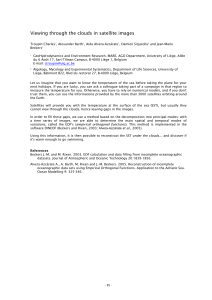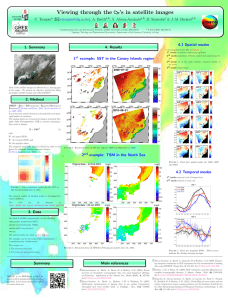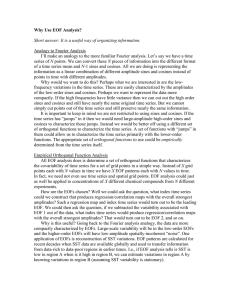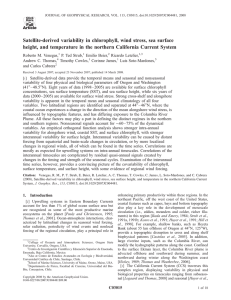Reconstruction of the Long-Term Satellite-Derived Sea Surface Temperature in the...
advertisement
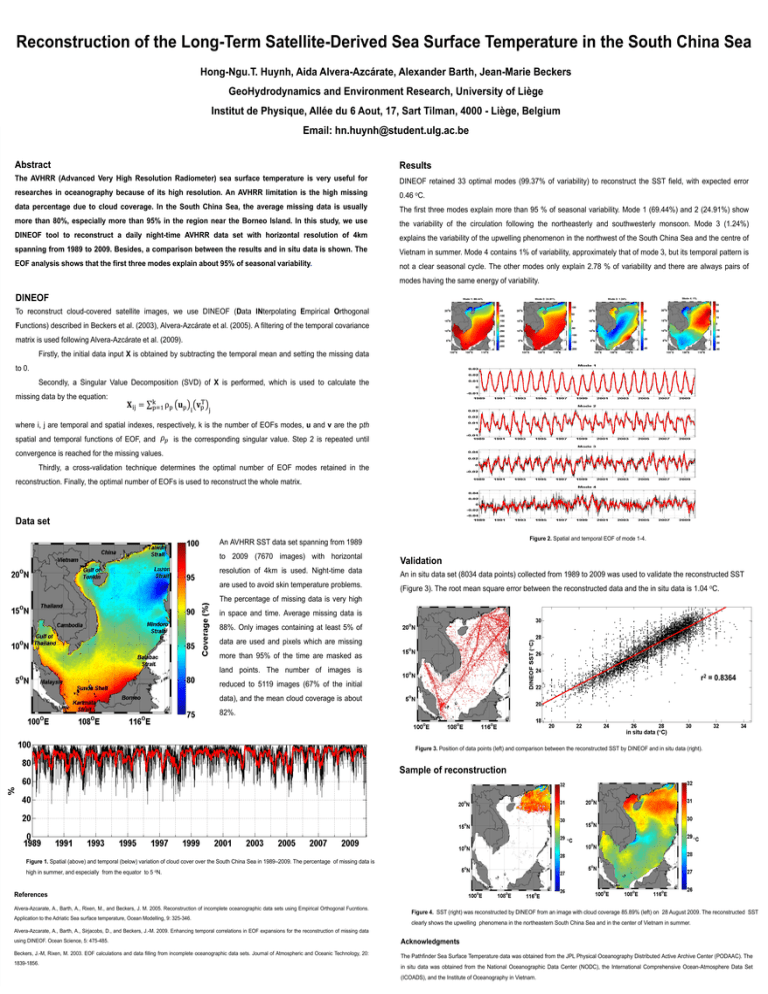
Reconstruction of the Long-Term Satellite-Derived Sea Surface Temperature in the South China Sea Hong-Ngu.T. Huynh, Aida Alvera-Azcárate, Alexander Barth, Jean-Marie Beckers GeoHydrodynamics and Environment Research, University of Liège Institut de Physique, Allée du 6 Aout, 17, Sart Tilman, 4000 - Liège, Belgium Email: hn.huynh@student.ulg.ac.be Abstract Results The AVHRR (Advanced Very High Resolution Radiometer) sea surface temperature is very useful for DINEOF retained 33 optimal modes (99.37% of variability) to reconstruct the SST field, with expected error researches in oceanography because of its high resolution. An AVHRR limitation is the high missing 0.46 oC. data percentage due to cloud coverage. In the South China Sea, the average missing data is usually The first three modes explain more than 95 % of seasonal variability. Mode 1 (69.44%) and 2 (24.91%) show more than 80%, especially more than 95% in the region near the Borneo Island. In this study, we use the variability of the circulation following the northeasterly and southwesterly monsoon. Mode 3 (1.24%) DINEOF tool to reconstruct a daily night-time AVHRR data set with horizontal resolution of 4km explains the variability of the upwelling phenomenon in the northwest of the South China Sea and the centre of spanning from 1989 to 2009. Besides, a comparison between the results and in situ data is shown. The Vietnam in summer. Mode 4 contains 1% of variability, approximately that of mode 3, but its temporal pattern is EOF analysis shows that the first three modes explain about 95% of seasonal variability. not a clear seasonal cycle. The other modes only explain 2.78 % of variability and there are always pairs of modes having the same energy of variability. DINEOF To reconstruct cloud-covered satellite images, we use DINEOF (Data INterpolating Empirical Orthogonal Functions) described in Beckers et al. (2003), Alvera-Azcárate et al. (2005). A filtering of the temporal covariance matrix is used following Alvera-Azcárate et al. (2009). Firstly, the initial data input X is obtained by subtracting the temporal mean and setting the missing data to 0. Secondly, a Singular Value Decomposition (SVD) of X is performed, which is used to calculate the missing data by the equation: where i, j are temporal and spatial indexes, respectively, k is the number of EOFs modes, u and v are the pth spatial and temporal functions of EOF, and is the corresponding singular value. Step 2 is repeated until convergence is reached for the missing values. Thirdly, a cross-validation technique determines the optimal number of EOF modes retained in the reconstruction. Finally, the optimal number of EOFs is used to reconstruct the whole matrix. Data set Figure 2. Spatial and temporal EOF of mode 1-4. An AVHRR SST data set spanning from 1989 to 2009 (7670 images) with horizontal Validation resolution of 4km is used. Night-time data An in situ data set (8034 data points) collected from 1989 to 2009 was used to validate the reconstructed SST are used to avoid skin temperature problems. (Figure 3). The root mean square error between the reconstructed data and the in situ data is 1.04 oC. The percentage of missing data is very high in space and time. Average missing data is 88%. Only images containing at least 5% of data are used and pixels which are missing more than 95% of the time are masked as land points. The number of images is r2 = 0.8364 reduced to 5119 images (67% of the initial data), and the mean cloud coverage is about 82%. Figure 3. Position of data points (left) and comparison between the reconstructed SST by DINEOF and in situ data (right). Sample of reconstruction Figure 1. Spatial (above) and temporal (below) variation of cloud cover over the South China Sea in 1989–2009. The percentage of missing data is high in summer, and especially from the equator to 5 oN. References Alvera-Azcarate, A., Barth, A., Rixen, M., and Beckers, J. M. 2005. Reconstruction of incomplete oceanographic data sets using Empirical Orthogonal Fucntions. Application to the Adriatic Sea surface temperature, Ocean Modelling, 9: 325-346. Figure 4. SST (right) was reconstructed by DINEOF from an image with cloud coverage 85.89% (left) on 28 August 2009. The reconstructed SST clearly shows the upwelling phenomena in the northeastern South China Sea and in the center of Vietnam in summer. Alvera-Azcarate, A., Barth, A., Sirjacobs, D., and Beckers, J.-M. 2009. Enhancing temporal correlations in EOF expansions for the reconstruction of missing data using DINEOF. Ocean Science, 5: 475-485. Acknowledgments Beckers, J.-M, Rixen, M. 2003. EOF calculations and data filling from incomplete oceanographic data sets. Journal of Atmospheric and Oceanic Technology, 20: The Pathfinder Sea Surface Temperature data was obtained from the JPL Physical Oceanography Distributed Active Archive Center (PODAAC). The 1839-1856. in situ data was obtained from the National Oceanographic Data Center (NODC), the International Comprehensive Ocean-Atmosphere Data Set (ICOADS), and the Institute of Oceanography in Vietnam.
